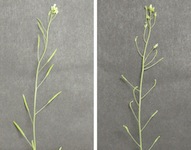 Roles of ER quality control in plant growth and development
Roles of ER quality control in plant growth and developmentThe endoplasmic reticulum (ER) is the site of protein synthesis in the eukaryotic secretory pathway. After synthesis, proteins fold into their native conformations, exit the ER and are transported to their destinations. However, many proteins in the ER fail to achieve their correct folding state. Cellular stresses could enhance production of such misfolded or aberrant proteins. The ER has a quality control system, which retains aberrant proteins in the ER and ensures that only correctly folded proteins are deployed to their final destinations. The pictures show wild-type (left) and an ER quality control-defective mutant (right) Arabidopsis plants grown at 29°C. When they are grown at around 20°C, the mutant does not show any visible phenotype. In contrast, the mutant plants did not produce seeds under heat-stressed conditions, mainly due to defects in pollen formation. Thus, ER quality control is important for resistance to cellular stresses.
(Photo by Dr. Shuh-ichi Nishikawa in Niigata University)
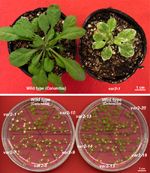 Defective chloroplast development and 'leaf variegation'
Defective chloroplast development and 'leaf variegation'The chloroplast is an organelle that is originated from endosymbiosis of ancestral cyanobacterium. In plant cells, chloroplasts are equipped with sophisticated machineries driving photosynthesis, where perception of light energy and fixation of atmospheric carbon dioxide take place. Mature chloroplasts in mesophyll cells develop the thylakoid, a sac-like inner membrane structure, which occasionally forms a complex membrane network. Well-developed chloroplasts contain a layer of thylakoidal stacks called grana, and perform photosynthetic light reactions. A mutation in thylakoid development may lead to leaf chlorosis and ultimately to the loss of viability. In contrast, several mutants are known to give rise to variegation, in which viable leaves have two sectors that contain normal chloroplasts or abnormal plastids. An example of leaf variegation in Arabidopsis var2 mutant is shown in the photograph. Mutants showing leaf variegation are the good resource to unravel molecular mechanisms controlling thylakoid development. Thus, leaf variegation exemplifies a common phenotype resulting from the loss of chloroplast function.
(Photo by Dr. Wataru Sakamoto in Okayama University)
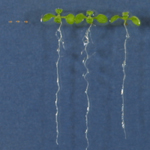 Defect of lipid metabolism in peroxisomes of β-oxidation mutant
Defect of lipid metabolism in peroxisomes of β-oxidation mutantSeeds require energy for germination. For example, Arabidopsis plants obtain energy as sucrose by metabolism of seed-storage lipids. This picture shows plants 7-days after sowing. The right three seedlings are wild type plants, but the left three seedlings are ped1 mutants which cannot grow normally. The ped1 mutant has a defect in one enzyme, 3-ketoacyl-CoA thiolase, which acts in the β-oxidation in peroxisomes. β-oxidation in peroxisomes is involved in lipid metabolism during germination. Therefore, the ped1 mutant can not utilize valuable storage lipids because of the defect of β-oxidation. Bar = 1 cm. (Photo by Dr. Shoji Mano in National Institute for Basic Biology)
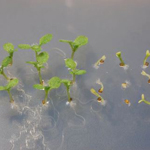 Defect of ATP transport from the cytosol into peroxisomes
Defect of ATP transport from the cytosol into peroxisomesSeveral metabolic pathways require energy, such as ATP, to function normally. This movie shows germination of Arabidopsis seeds. The left and right nine seeds are derived from wild type and pnc1/2i plants, respectively. pnc1/2i plants were generated by RNAi interference technology to reduce the functions of both PNC1 and PNC2 proteins, which have roles in ATP transport from the cytosol into peroxisomes. In pnc1/2i seeds, metabolism of fatty acids in the peroxisomes is dramatically inhibited, since an energy shortage occurs in the peroxisomes by a decrease of ATP transport. As a result, peroxisomes can not provide sufficient energy for germination in pnc1/2i seeds. Movie shows 9,000 times faster than real time.
(Movie by Drs. Yuko Kichise-Arai and Tomoko Kurata in National Institute for Basic Biology)
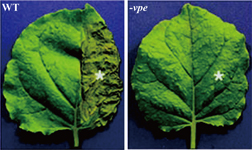 Defect of vacuole processing enzyme for programmed cell death
Defect of vacuole processing enzyme for programmed cell deathPlants are also attacked by bacteria and viruses. Programmed cell death (PCD) is one of the countermeasures, which kills the plant’s own cells, to prevent bacteria and viruses spreading to other cells. Both pictures show tobacco leaves in which half of each leaf (right region represented by asterisk) was infected with tobacco mosaic virus. The left picture shows the leaf from a wild type plant. PCD occurs in the infected region. In contrast, the right picture shows the leaf from the transgenic tobacco plant whose vacuolar processing enzyme (VPE) gene is silenced. VPE is involved in maturation of various proteins in the vacuole. PCD does not occur in this leaf, and it looks healthy. However, viruses propagate in this leaf, spread to the whole plant, and the plant finally withers and dies. Thus, the vacuole-mediated PCD is an important mechanism for plants to prevent the spread of bacteria and viruses.
(Photos by Drs. Noriyuki Hatsugai and Ikuko Hara-Nishimura in Kyoto University)